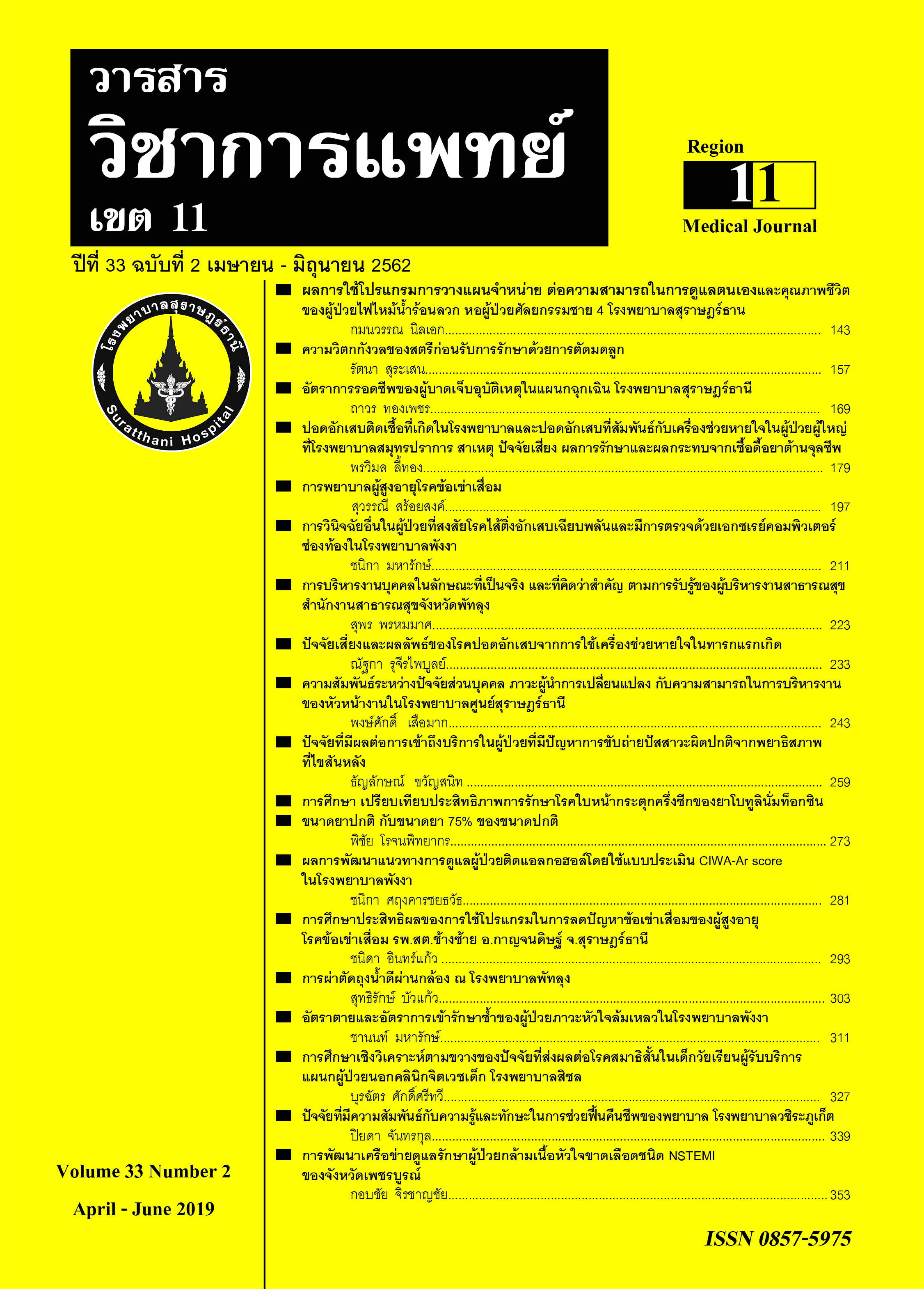Hospital Acquired Pneumonia and Ventilator Associated Pneumonia in Adults at SamutprakarnHospital : Etiology Clinical outcomes and Impact factors of Antimicrobial Resistance
Keywords:
Nosocomial pneumonia, Hospital-acquired Pneumonia, Ventilator associated PneumoniaAbstract
Background : Hospital Acquired Pneumonia (HAP) and Ventilator Associated Pneumonia (VAP) is an important cause of morbidity and mortality in hospitalized patients. The main contributing factors to a high mortality rate of HAP and VAP could be antibiotic resistance among the causative agents.
Objective : To determine prevalence of bacterial pathogens clinical features, risk factors of HAP and VAP, antimicrobial resistance among major respiratory pathogens, antibiotic used and clinical outcome of patients with HAP and VAP at Samutprakarn Hospital.
Material and Method : This was a prospective, hospital based and active surveillance study on HAP and VAP in adults patients at Samutprakarn Hospital form January 2017 to May 2018. The patients with HAP and VAP were followed prospectively until they were discharged or expired from the hospital.
Results : One hundred and seventy adult patients were include. Sixty percent of the patients were male with mean age of 70.4 years. HAP was accounted for 38.8% and VAP 61.2%. Most of the patients (85.9%) had late-onset of HAP and VAP with the median day of onset of pneumonia of 10 days. Fifty-eight percents of patients were hospitalized in general medical wards and 26% were diagnosed to respiratory tract infection at admission. The most common comorbidity disease are diabetic mellitus and cerebrovascular disease. Bronchopneumonia was observed in 52.4% and multilobar pneumonia in 19.4%. A. baumanii was the most common isolated pathogen and 97.6% of them were multidrug resistance (MDR). The others common isolated pathogen were K.pneumoniae (Carbaenem resistance Enterobacteriaceae, CRE), P.aureuginasa (MDR),S.multophilia and Methicillin resistance S.aureus (MRSA). Carbapenem
was the most commonly used initial antibiotic (47.1%) followed by penicillin and derivative and colistin (25.3%). The concordance of initial antibiotics was 61.8% and antibiotic were modified 46.5% of the patients. Colistn and quinolone were modified followed by carbapenem. The modified antibiotics were concordant with isolated bacteria in 92.4%. The patients received mechanical ventilators in 62.4% and with the median ventilator day of 11 days. At the initial response (72 hours after antibiotic therapy) an improvement was 64.1% and a mortality rate due to pneumonia was 16.5%. Death due to pneumonia at the end of treatment and 30-day mortality from pneumonia were 54.1% and 50.0%. Septic shock, bilateral lung, multilobar pneumonia and previous carbapenem usage within 72
hours were significantly associated with unfavorable outcomes at 72 hours. Severe sepsis, septic shock , bilateral lung , multilobar pneumonia and previous carbapenem usage within 72 hours, pneumonia due to A.baumanii (MDR) and K.pneumoniae (CRE) were significantly associated with mortality at the end of treatment and pneumonia due to P.aureuginasa (MDR) and A.baumanii (MDR) were significantly at 30-days after developing pneumonia. There were no significant differences in the outcomes of pneumonia between HAP and VAP. The factors associated with MRD-organism were late onset of HAP and VAP and previous carbapenem usage within 72 hours.
Conclusion : HAP and VAP remain to be very important hospital-acquired infections at Samutprakarn Hospital. The isolated pathogens are usually multidrug-resistant and high rate of mortality. The local data on prevalence of isolated pathogens and antibiotic susceptibility may help clinicians choose more appropriate initial antibiotics to improve outcome and to decrease the mortality and the emergence of resistant organisms.
References
2. Danchaivijitr S, Jadaeng T, Sripalakij S, Naksawas K, Plipat T. Prevalence of nosocomial infection in Thailand 2006. J Med Assoc Thailand. 2007;90(8):1524-9.
3. Werarak P, Kiratisin P, Thamlikitkul V. Hospital-acquired pneumonia and ventilator-associated pneumonia in adults at Siriraj Hospital: etiology, clinical outcomes, and impact of antimicrobial resistance. J Med Assoc Thailand. 2010;93 Suppl 1:S126-38.
4. Reechaipichitkul W, Phondongnok S, Bourpoern J, Chaimanee P. Causative agents and resistance among hospitalacquired and ventilator-associated pneumonia patients a Srinagarind Hospital, northeastern Thailand. Southeast Asian J Trop Med Public Health. 2013;44(3):490-502.
5. Chung DR, Song JH, Kim SH, Thamlikitkul V, Huang SG, Wang H, et al. High prevalence of multidrug-resistant nonfermenters in hospital-acquired pneumonia in Asia. Am J Res Crit Care Med. 2011;84(12):1409-17.
6. Inchai J, Pothirat C, Liwsrisakun C, Deesomchok A, Kositsakulchai W,Chalermpanchai N. Ventilator-associated pneumonia: epidemiology and prognostic indicators of 30-day mortality. Jpn J Infect Dis. 2015;68(3):181-6.
7. Chittawatanarat K, Jaipakdee W, Chotirosniramit N, Chandacharm K, Jirapongcharoenlap T. Microbiology, resistance patterns, and risk factors of mortality in ventilator-associated bacterial pneumonia in a Northern Thai tertiary-care university based general surgical intensive care unit. Infect Drug Resist. 2014;7:203-10.
8. Nseir S, Favory R, Jozefowicz E, Decamps F, Dewavrin F, Brunin G, et al. Antimicrobial treatment for ventilator-associated tracheobronchitis: a randomized, controlled, multicenterstudy. Crit Care (London, England). 2008;12(3):R62
9. Leone M, Bechis C, Baumstarck K, Lefrant JY, Albanese J, Jaber S, et al. De-escalation versus continuation of empirical antimicrobial treatment in severe sepsis: a multicenter non-blinded randomized noniferiority trial. Intensive Care Med. 2014;40(10);1399-408.
10. Tablan OC, Anderson LJ, Besser R, Bridges C, Hajjeh R. Guidelines for preventing health-care—associated pneumonia, 2003: recommendations of CDC and the Healthcare Infection Control Practices Advisory Committee. MMWR Recomm Rep. 2004;53(Rr-3):1-36.
11. Klompas M, Branson R, Eichenwald EC, Greene LR, Howell MD, Lee G, et al. Strategies to prevent ventilator-associated pneumonia in acute care hospitals:2014 update. Infect Control HospEpidemiol. 2014;35 Suppl 2:S133-54.
12. Kalil Ac, Metersky ML, Klompas M, Muscedere J, Sweeney DA, Palmer LB, et al. Management of Adults With Hospital-acquired and Ventilator-associated Pneumonia: 2016 Clinical Practice Guidelines by the Infectious Diseases Society of America and the American Thoracic Society. ClinInfect Dis. 2016;63(5):e61-e111.






